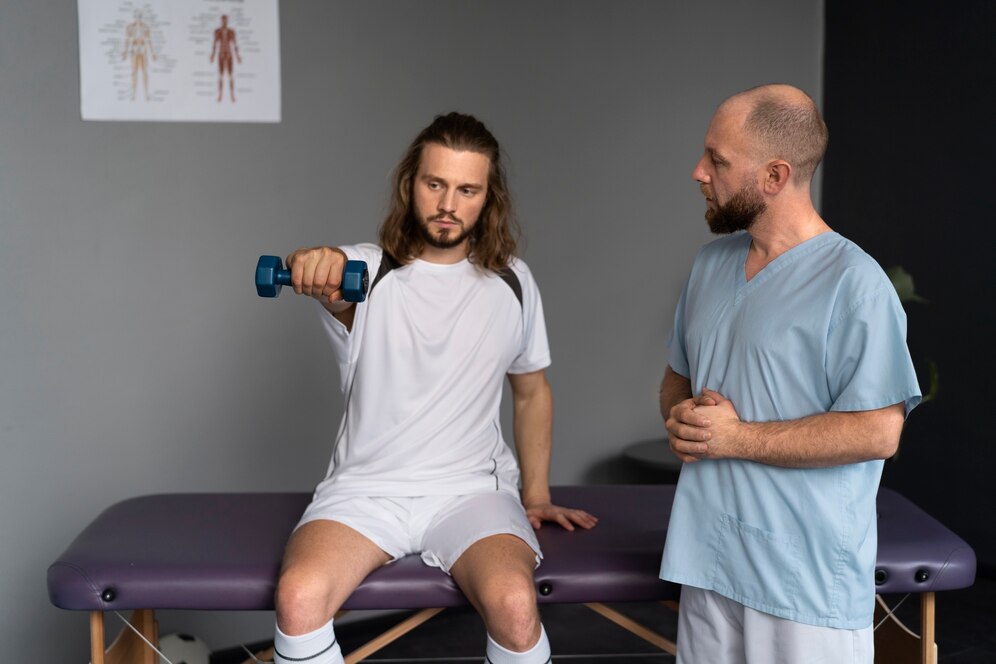Sports injuries are a frequent concern for athletes and active individuals. A Sports Physiotherapy Clinic in Mulund West plays a vital role in treating and managing these injuries. Their expertise helps in promoting recovery and preventing future injuries. In this article, we will explore the top 15 common sports injuries treated by physiotherapists.
Ankle Sprains
One of the most typical sports injuries is an ankle sprain. They happen when the ankle’s ligaments are ripped or overextended. Physiotherapists employ a range of methods to lessen pain and swelling, such as exercises and manual therapy. They also aid in regaining the ankle’s flexibility and strength. This method reduces the possibility of further sprains.
Hamstring Strains
Running and jumping are two common activities that cause hamstring injuries. The hamstring muscle fibers can get overextended or damaged, resulting in strains. Initially, physiotherapists concentrate on lowering pain and inflammation. To aid in recovery, they then add stretches and strengthening exercises. It is advised to gradually resume activities to avoid recurrence.
ACL Injuries
For knee stability, the anterior cruciate ligament (ACL) is essential. ACL injuries are frequent in sports involving abrupt stops and direction changes. Physiotherapists support ACL injury patients during their post-surgery recovery. They lead patients through a planned exercise regimen to regain function in their knees. Exercises for balance and strength are essential to this recovery.
Shoulder Dislocations
When the upper arm bone separates from the shoulder socket, it results in a shoulder dislocation. This injury may result in tissue damage to the surrounding areas and can be extremely painful. Physiotherapists employ targeted exercises to regain strength and stability in the shoulder. Additionally, they teach patients how to avoid dislocations in the future.
Tennis Elbow
Overuse of the elbow can lead to lateral epicondylitis, sometimes known as tennis elbow. The outside portion of the elbow experiences pain and tenderness as a result. Manual therapy and focused exercises are the methods used by physiotherapists to treat this illness. Their main goal is to increase the forearm muscles’ strength and flexibility. This method aids in pain relief and recurrence prevention.
Groin Strains
Sports involving abrupt movements frequently result in groin strains, which damage the muscles of the inner thighs. To treat pain, physiotherapists combine rest, ice, and light stretching. To restore function, strengthening exercises are added gradually. It is advised to follow appropriate stretching and warm-up protocols to avoid further strains.
Shin Splints
A common condition among runners, shin splints produce pain along the shin bone. Physiotherapists concentrate on using cold and rest to lessen pain and inflammation. To address contributory issues, they also examine footwear and running mechanics. Lower limb strengthening and flexibility exercises are also crucial to the course of treatment.
Achilles Tendonitis
An overuse injury that affects the Achilles tendon is called Achilles tendonitis. The back of the ankle becomes stiff and painful as a result. To treat symptoms, physical therapists employ stretching exercises and manual therapy. To encourage tendon recovery, they also advise eccentric strengthening workouts. To stop recurrence, appropriate footwear and exercise changes are recommended.
Patellar Tendonitis
The tendon that connects the kneecap to the shinbone is impacted by patellar tendinitis, also known as jumper’s knee. It results in soreness and inflammation near the kneecap. Physiotherapists employ techniques such as cold packs and ultrasounds to lessen discomfort and swelling. They also provide hamstring and quadriceps strengthening and stretching activities. This method aids in function restoration and symptom relief.
Concussions
One kind of traumatic brain damage that frequently occurs in contact sports is concussions. Physiotherapists are essential to the care of concussions. They evaluate and track symptoms, assisting with a phased-in return to activities. Exercises for balance and coordination are frequently incorporated into the rehabilitation regimen. Additionally, there is education on preventing concussions.
IT Band Syndrome
The outside side of the knee hurts when you have iliotibial band syndrome. It is typical of cyclists and runners. Physiotherapists release tightness in the IT band by stretching and foam rolling patients. It’s also advised to perform hip and thigh strengthening exercises. This method aids in pain relief and recurrence prevention.
Plantar Fasciitis
Foot discomfort in the heel and bottom is a common symptom of plantar fasciitis. It is typical of athletes and runners who engage in prolonged standing. Stretching and strengthening exercises are used by physiotherapists to treat pain. To support the foot’s arch, they also advise using appropriate footwear and orthotics. This all-encompassing strategy aids in symptom management and recurrence prevention.
Rotator Cuff Injuries
Shoulder stabilization muscles and tendons are impacted by rotator cuff injury. They may be brought on by trauma or overuse. To increase shoulder strength and flexibility, physiotherapists employ targeted exercises and manual therapy. Additionally, they teach patients the right ways to prevent more injuries. Exercises that are gradually progressed aid in the full restoration of shoulder function.
Stress Fractures
Stress fractures are microscopic fissures in the bone brought on by repeated stress. Those who participate in high-impact sports frequently experience them. The goals of physical therapists are rest and a gradual return to activity. They also address things like bad training habits and inappropriate footwear. Exercises for strengthening are added to help the afflicted area.
Groin Pulls
When the muscles in the inner thigh are overextended or damaged, groin pulls happen. To treat pain, physiotherapists combine rest, ice, and light stretching. To restore function, progressively more strenuous activities are added. It is advised to follow appropriate stretching and warm-up protocols to avoid further strains.
Physiotherapists are crucial in the management of various sports-related injuries. Their knowledge enables athletes to recuperate more quickly and securely resume their activities. They address injury symptoms and underlying causes by combining focused exercises and rehabilitation procedures. This all-encompassing strategy guarantees a more efficient and rapid recuperation process. Visiting a physiotherapist regularly might also aid in preventing injuries. They offer helpful advice on appropriate methods and training adjustments. Athletes can limit the chance of future injuries and preserve their performance with their support. Physiotherapists provide a route to recovery and enhanced physical well-being, regardless of the nature of the ailment—from an acute injury to a chronic illness.


